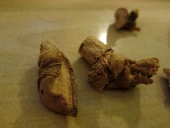ok now,...
i don`t know where i had my head yesterday. was thinking about deleting the last post for its poor information. it`s been a while since i went to school and the routine did get hold of me since then, but fortunately most of it came back to me last night.(,i believe

)
"red brittleness" or "hot brittleness" (direct translation from german; don`t know and can`t find english term) is caused by sulphur and carbon in hot (red glowing) steel and makes it brake apart. so sulphur is less a problem in low carbon "construction material" steel (soft steel). it is a problem in high carbon steel (hard steel).
if you use a (anthracite) coal fire you pile the new coal around the fire and pour water on it from time to time. this helps drive out the sulphur from the coal before it gets in contact with the steel (you can even see it as a thick yellowish smoke rising from fresh coals).
if you are forging (high carbon) blade steel, it is generally recommended to use char coal (which contains no sulphur) or at least a mix with charcoal. especially if you want to weld it, because the higher the temperature the more sulphur could diffuse into the steel.
a coal fire is generally a pit containing burning coal with a possibility to blow in air surrounded by a heap of non-burning coal. this creates different zones in the fire that can be used for different purposes (i.e.:burn of coatings, lowering the carbon content of the steel,...). for forging you generally want your stock in the zone that is the hottest but has no more oxygen left and also no contact to the surrounding air. that is, it is covered by burning coal on all sides that keep oxygen out (and of course heat your stock faster). this is called the reducing part of the fire.
in a rocket stove the equivalent would be directly in the heat riser and it would only exist if there were no excess oxygen. i believe both my rockets and most other well functioning rockets i have seen have at least a little excess oxygen (mine i think have plenty, which of course is not ideal in any case). for a rocket forge you would need to be able to control the airflow very accurately to the point, where it juust stops smoking. but i am sure people have made such devices already.
and then of course all my objections only make sense if you want a forge for serious work. to just make steel glowing hot, play around a little, forge some nails or hooks or spikes almost any decent rocket without barrel will do...
i hope this paints a more complete picture.
take care,
afghani
but man i can`t stop thinking about this rocket forge. i really have been sick of buying coal for a long time. there has to be a way...






 )
)


 )
)

